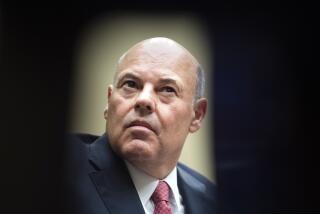Clinton Pushing the Envelope on U.S. Postal Service Savings
- Share via
WASHINGTON — Forty-seven-thousand budget-related resignations later, the U.S. Postal Service is searching for a new way put its finances in order, and the solution is likely to affect just about everyone who uses the mail.
Despite last summer’s massive $2-billion restructuring plan, which slashed 30,000 jobs and led to the early retirement of more than 47,000 workers, the Clinton Administration’s budget calls for the postal service to “contribute” another $2 billion in the name of deficit reduction.
Postmaster General Marvin T. Runyon contends that with little fat now remaining in the ranks of middle management--which already have been severely trimmed--he has been left with few options.
The most likely sources of new revenue appear to be raising the reduced postage rates enjoyed by more than 400,000 nonprofit organizations nationwide and increasing regular residential and commercial postal rates ahead of schedule.
BACKGROUND: Upon taking office as head of the independent agency last summer, the postmaster general was faced with an inefficient and bloated system of management, unhappy workers and, perhaps most important, a projected $2-billion deficit in fiscal year 1993.
Runyon immediately unveiled a proposal to dramatically cut costs and reshape upper management into a more corporate-like structure, eliminating 30,000 management and support positions.
Despite a handful of complaints about job placement for affected workers and minority hiring in the Washington, D.C., headquarters, the plan has generally earned Runyon praise, or at least grudging respect, from just about everyone, including members of Congress, major mailer organizations and even union officials.
Runyon had warned that without the plan it might have been necessary to raise the cost of a first-class letter to 35 cents. Afterward, he predicted that rates would remain steady at least through 1994. Now, however, the results of his cost-cutting plan are in jeopardy.
ISSUES: The Administration has targeted the postal service as a ready source of cash, seeking a combination of one-time and annual budget cuts totaling $2 billion.
Since 1951, Congress has paid the postal service’s overhead costs for the mail of nonprofit groups, requiring the groups to pay only the direct costs of their mail--a savings of 5 to 7 cents per letter.
At the start, the cost was relatively small; only 12,000 organizations applied for the discounted rates. The number has now exploded to 400,000, costing the government $531 million annually.
The Clinton budget calls for elimination of the subsidy for all groups except the blind and those voting absentee from overseas, forcing the postal service to make up the more than $450-million annual difference.
Under the plan, the postal service also will be charged a one-time fee of $1 billion spread out over three years for an apparent miscalculation in 1990 of retired workers’ health costs.
OUTLOOK: Although Runyon has warned of the possibility of laying off more workers, closing rural post offices or even cutting back on mail delivery, a compromise worked out by Rep. William L. Clay (D-Mo.), chairman of the House committee that oversees the service, may have resolved the issue without such painful consequences.
The $1-billion one-time charge for retirees’ benefits will be rolled into a future rate increase, forcing residential and commercial postage rates to increase sooner than expected--probably next year.
Negotiations on the nonprofit mailers’ subsidy were a bit more complicated, but in the end it appears that the costs of the subsidy will be split almost evenly between the nonprofit organizations and commercial/residential mailers.
More to Read
Sign up for Essential California
The most important California stories and recommendations in your inbox every morning.
You may occasionally receive promotional content from the Los Angeles Times.










